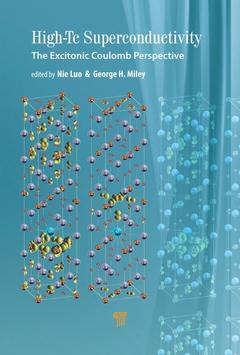High-Tc Superconductivity The Excitonic Coulomb Perspective
Auteurs : Luo Nie, Miley George H.

The exciton mechanism of high-Tc superconductivity in copper oxides was initially proposed by Prof. J. Bardeen. His insight is largely shared by another luminary in superconductivity, Prof. V. L. Ginzburg. The main author of the book, Dr. Nie Luo, was motivated by their insights to give a geometrical explanation to the excitonic Coulomb interaction and has developed a unique formalism to understand and predict physical properties of high-Tc superconductors. This work is supported by increasingly strong evidence for electron?hole interactions in p-type cuprates. The presence of electrons in hole-doped cuprates is revealed by the works of the authors and many others, including the late Prof. L. P. Gor?kov. The book also tries to understand the interlayer Coulomb (ILC) pairing model by the excitonic Coulomb interaction. Developed by Prof. A. J. Leggett, ILC theory shares many views with Ginzburg?s approach. The other author of the book, Prof. George H. Miley, shares with us his personal experience with Prof. Bardeen on the exciton?s role in physics problems including high-Tc superconductivity. The results and predictions of this excitonic Coulomb mechanism have been verified by an increasing number of experiments. This book summarizes the current status and fathoms future directions.
Excitonic Coulomb Pairing in a Variational Approach. Transport and Evidences for Electrons in P -type Cuprates. Interlayer Coulomb Instability, the Many-Body Approach. Where are Electrons Located in P -type Cuprates? Where are Electrons Located in P -type Cuprates? Superconducting Properties. Reflections on John Bardeen’s interest in the role of excitons in superconductivity.
Nie Luo collaborated with the E. Teller Medalist G. H. Miley for postdoc and later faculty research at the University of Illinois at Urbana-Champaign, USA, for over 10 years. Their collaboration led to fruitful results in superconductor phenomenology and a number of energy studies such as nuclear batteries, fuel cells, and nuclear pumped radiations. Dr. Luo was motivated by J. Bardeen’s exciton pairing for cuprate superconductivity and has been working in this direction for 22 years.
George H. Miley is a professor emeritus of physics and engineering at the University of Illinois at Urbana–Champaign, USA. He is a Guggenheim Fellow and a fellow of the American Nuclear Society, the American Physical Society, and the Institute of Electrical and Electronic Engineers. He was senior NATO fellow from 1994 to 1995, and he received the Edward Teller Medal in 1995, the IEEE Nuclear and Plasma Science Award in Fusion Technology in 2003, and the Radiation Science and Technology Award in 2004. Prof. Miley holds several patents on nuclear fusion.
Date de parution : 02-2021
15.2x22.9 cm
Thèmes de High-Tc Superconductivity :
Mots-clés :
Fermi Surface; Interlayer Coulomb; Superconducting Cuprates; Excitonic Coulomb interaction; Transition Metal; High-Tc superconductivity; Green’s Function; Hole-doped cuprate; Underdoped Regime; Excitonic Coulomb pairing; Pseudogap Phase; Fermi Arc; Interlayer Coupling; MT Sphere; Coulomb Repulsion; Fermi Level; HTSC; ARPES Experiment; Band Mass; Fs Topology; Saddle Point; Green’s Function Formalism; BCS Theory; Iron Pnictides; Single Parabolic Band; Optical Conductivity; Bec; Hall Coefficient; Sr Dopant; Cooper Pair


